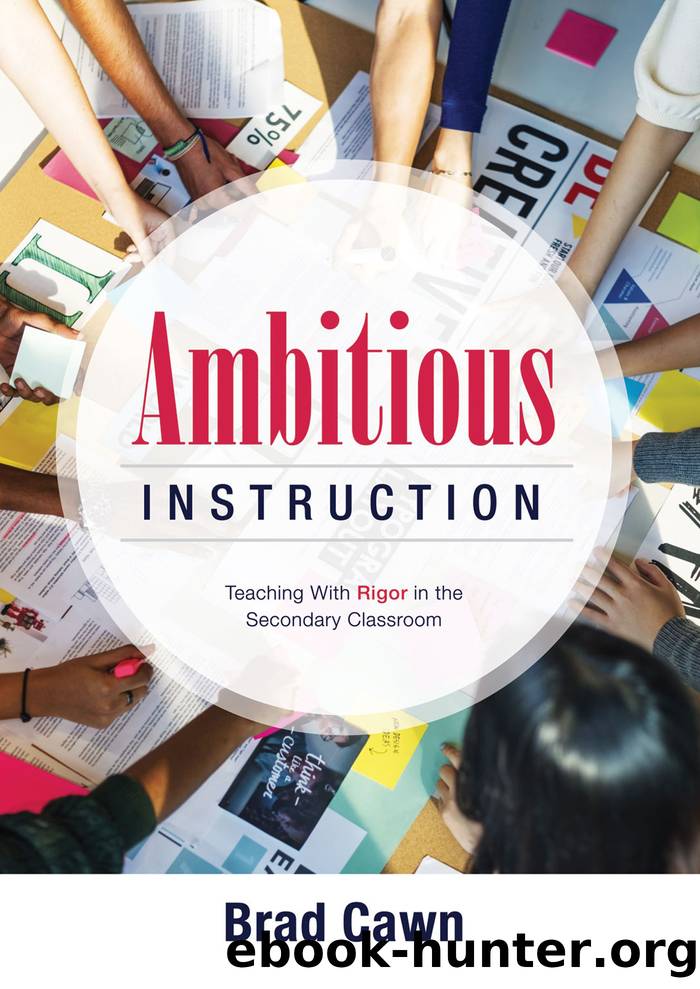Ambitious Instruction by Cawn Brad;

Author:Cawn, Brad;
Language: eng
Format: epub
Publisher: Solution Tree
Published: 2020-08-15T00:00:00+00:00
Connecting (Forty-Five to Ninety Minutes)
At first glance it may seem prudent to focus initial student engagement with texts purely on comprehension. Understandably, the problem and the texts may be complex; there may be a lot to read or write or do during the investigation. Our instinct is not wrong in wanting to make sure students get it before going deeper.
But focusing solely on understanding the main ideas of each text, or even just identifying similarities and differences among texts, is not sufficient to enable synthesis (Kobayashi, 2015). Even at the outset of the investigation, our key goal has to be positioning students to move beyond a mere surface or superficial level of the text, or even across texts, and toward higher-order thinking during their reading. Of course, we do want students to understand the gist of the arguments or descriptions that the text provides, but we want them to do so in support of understanding the landscape of the problem they are investigating. Furthermore, we want students to make connectionsâthat is, not merely comprehend content but also begin to draw analytical relationships among ideas and in response to the problem.
To do so, initial engagement with the texts needs to position students to engage in three performances concurrently and flexibly: (1) leveraging what they are learning and applying from previous positioning, (2) reading within and across texts for both literal and inferential purposes, and (3) developing understanding through discussion and consensus building. Given these demands and opportunities, the four-part sequence that follows features a significant amount of chunking of tasks, lots of quick and engaging movement between independent and collaborative activity, and plenty of options in terms of how the teacher or students could choose to tackle the texts.
Note: This component of the task is likely to comprise the most instructional time of any in the sequence; it may extend across multiple periods or days. Of course, time on task here will vary based on the number of texts students will read and their complexity, studentsâ readiness and familiarity with the content, performance, and so onâitâs an instructional situationâspecific decision.
I devised the following four steps that discuss setting up initial engagement.
1. Preview the landscape: Provide students with a macro-, high-level understanding of the texts and investigation by looking quickly and briefly at an element of the content that best conveys the range of ideas and issues students will investigate. This can be the launch text or your nonprint source, assuming either is part of the investigation (you can also reread, if relevant). Most likely, however, youâll want to grab short excerptsâa quote or a paragraph, sayâfrom each of the texts. The excerpt you select should be the sentences that capture the ideas in the text most compelling to the investigation. With these blurbs, youâll want to prompt and facilitate students to do two things: (1) be able to restate what each piece is about in their own words and (2) create a quick classification scheme (for example, pro-or-con, common solution or alternative solution) that they can use as a label for each text.
Download
This site does not store any files on its server. We only index and link to content provided by other sites. Please contact the content providers to delete copyright contents if any and email us, we'll remove relevant links or contents immediately.
Deep learning with TensorFlow and Keras by Derrick mwiti(883)
Understanding PDA Autism in Kids: A Guide for Parents and Teachers to Support Neurodiverse Learners by Jehu Len(763)
The Victorian Era: A Captivating Guide to the Life of Queen Victoria and an Era in the History of the United Kingdom Known for Its Hierarchy-Based Social Order by Captivating History(549)
Writing Solid Code: Development Philosophies for Writing Bug-Free Programs by Steve Maguire(494)
100 Ideas for Secondary Teachers: Engaging Parents by Janet Goodall & Kathryn Weston(489)
Intersectionality in Educational Research by Dannielle Joy Davis; James L. Olive; Rachelle J. Brunn-Bevel; Susan R. Jones(488)
How to be assertive in any situation by Hadfield Sue & Hasson Gill(475)
Brain Teasers to Build Critical Thinking Skills: Brain Exercises for Tech, Banking, Case Interview Prep, and to Keep Your Mind Sharp by Kris Safarova(464)
Brain Teasers to Build Critical Thinking Skills by Safarova Kris(462)
Python 101 - Fundamentals by Sam(427)
Critical Curriculum Leadership : A Framework for Progressive Education by Rose M. Ylimaki(425)
The Art of Emotional Validation: Improve Your Communication Skills and Transform Your Relationships by Validating Emotions and Feelings by Emily Wright(394)
A Beginner's Guide to SSD Firmware by Unknown(383)
The Knights Templar: An Enthralling History of the Rise and Fall of the Most Influential Catholic Military Order by Wellman Billy(382)
What Every Teacher Should Know about Learning, Memory, and the Brain by Tileston Donna E. Walker;(378)
The Future Knowledge Compendium by Ellyard Peter;(376)
NumPy : From Basic to Advance by bisht Karan Singh(367)
Alma Maters (5th edition) by Unknown(360)
Making Connections in and Through Arts-Based Educational Research by Hala Mreiwed Mindy R. Carter Sara Hashem Candace H. Blake-Amarante(352)
